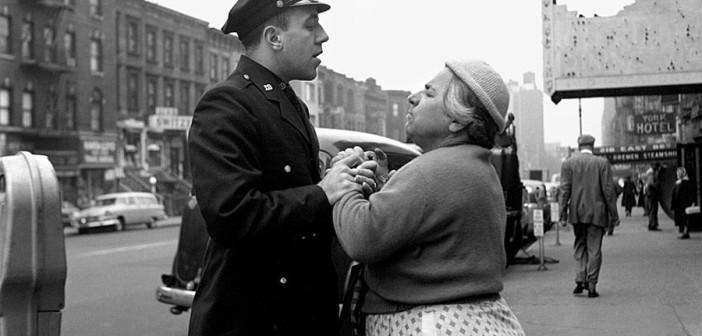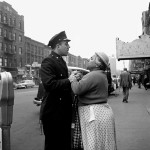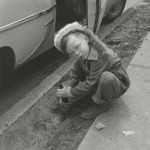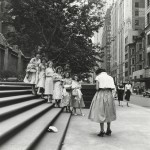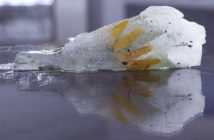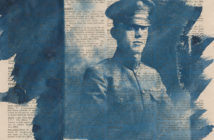At Brandeis University’s Women’s Studies Research Center through December 18, Vivian Maier: A Woman’s Lens may be the first exhibition of the elusive (some would say, reclusive) photographer’s work in the Greater Boston area, but it coincides with Self-Portraits at Howard Greenberg Gallery in New York, the publication of Vivian Maier: Self-Portraits by powerHouse Books, and the new documentary Finding Vivian Maier, which premiered as part of the DOC NYC film festival on November 17. Today, Maier’s work is shown in Moscow, Antwerp, London, and Los Angeles, and we know next to nothing about her.
Why would a photographer keep a private arsenal of over 100,000 negatives, not to mention thousands of rolls of film, undeveloped in storage lockers for decades? Why would she spend a life bearing witness to the etceteras of the world around her on invisible ledgers? It’s not a trick question, but we’ll most likely never know the answer. The auctioneer charged with emptying those lockers after their renter stopped making payment in 2007 threw away the journals that might have shed light on such an unusual practice. It was a young Chicago realtor John Maloof, paying a grand total of $400 for the contents of boxes he hoped would contain some useful negatives, who inadvertently rescued Vivian Maier from the dustbin of history. But the obscurity in which she lived and created some of the most poignant and profound street photographs of the 20th century is impenetrable. Over the last few years, a surge of interest in Maier’s work has pressed higher and higher against the barricades she herself seems to have built around her life, but to little avail.
 Vancouver, Canada, n.d.
Vancouver, Canada, n.d.Gelatin silver print; printed later
Vivian Maier/Maloof Collection courtesy of Howard Greenberg Gallery.
Maloof, one of three men who now own rights to the contents of Maier’s storage lockers, found her name scribbled on an envelope in one of the boxes he purchased, but a google search produced only one hit: the Chicago Tribune obituary from a few days before. At age 83, Vivian Maier took the secrets of her life’s work to the grave. The contradictions between her life and work, inseparable though they appear to be, are overwhelming. Maier had few personal relations and was enigmatic even to those whom she reared in her capacity as a nanny. Yet her self-portraits are legion, her face appearing in mirrors and reflections in windows, her shadow casting its authorial presence over her images. She revealed nothing in life and everything in art.
As a photographer myself, I am left wondering what drove Maier to make pictures she would never see, to express herself artistically through a prolific silence. It seems almost incomprehensible. Though she would take photos endlessly on the streets of New York City and Chicago, no one who knew Maier knew her to be a photographer. We have seen, at most, only 400 of her photos to date, but it is evident that her Rolleiflex, always on her person, was in a master image maker’s capable hands. It is the great mystery of her person, as much as her skill and vision, that fuels our interest.
Looking at her photographs on view at Brandeis, there are themes that emerge. Despite her carefully guarded solitude, Maier photographed couples holding hands, their heads leaning on shoulders, tenderly asleep in each other’s arms. She had affection for children and their play, rivaling Helen Levitt’s oeuvre. There are street portraits that recall Paul Strand or evoke the work of August Sander. Grand dames and the working poor, the destitute and the one percent, make their appearances in her catalogue of human life. Her mood can be as somber as Robert Frank’s, but it is tempered by her obvious humor. A man’s shoes are viewed through a shop window not yet open for business, its blinds still closed, sandwiched between cans of peaches. We can see Henri Cartier Bresson moments here, a father walking hand-in-hand with his children, their reflection following them amidst the branches in a large puddle on the ground. Maier’s shadow is cast as a Garry Winogrand wherever she goes, her admiration for beautiful women, or moments when legs are revealed under skirts in the wind, as clear. We can see whatever we want in these photographs, and do, largely because we know so little.
 New York City, September 10, 1955
New York City, September 10, 1955Gelatin silver print; printed later
Vivian Maier/Maloof Collection courtesy of Howard Greenberg Gallery.
Is it ironic that three men whom Maier never knew during her lifetime now own the rights to all of her work? Or is it merely a sad commentary on the status of women in the art world (which sounds like something from a UN Report)? A recluse, Maier cast a wide net over humanity and daily life alike. But the recognition she so rightly deserved was not to be. No one who saw her taking photos daily, her camera always with her, considered her to be a photographer, an artist, or asked to take a look at her work. And she, (we do not know why) did not offer to show her work, or even see much of it herself. Did she not consider herself to be a photographer or an artist, either? How could Maier have produced such work if that were the case?
Women have always been in photography since its invention, as PRC curator Francine Weiss made clear during the November 7th panel at Brandeis Turning the Wheel: The Emergence of Women Artists. But so many, among them Emma Jane Gay who documented the Nez Perce Indian Reservation in Idaho (but was barred from doing so in an official governmental capacity) or Charis Wilson, who pointed out "potential Westons" to her husband, went unrecognized and disregarded.
Maier is an extreme case of this negligence, but even today, women photographers hesitate to be cast as such. Kristen Gresh, curator of She Who Tells a Story at the MFA, remarked during the panel that she was warned against, as one man put it to her, the "very alarming," exhibition. He was concerned that the Middle East might be depicted as a sexist and inhospitable place for women by these Iranian and Arab photographers. A number of the artists Gresh selected initially hesitated to be included in an exhibition by and about women photographers. I would like to think that we should be surprised by this sentiment, but the sad truth is that we should not be. Women artists are underrepresented and undervalued, even today.
We cannot discover Maier, as she has been largely lost to the pages of history, but we can and must discover her work, all 150,000 and counting undeveloped prints. She is one of the great masters of 20th century street photography. While it is disheartening to think she did not know it herself, we are (in some sense) lucky. We are lucky that $400 salvaged her negatives from destruction (a terrible thought, but nonetheless pure luck). We are lucky to have these masterpieces, to have the pleasure of slowly unearthing the treasures within those rolls of film. We are lucky to have the Women’s Studies Research Center at Brandeis, so that those of us who call Boston home might see Maier’s work printed for the first time. And we are lucky, too, that the art world is receptive, albeit slowly, to Vivian Maier’s legacy. But perhaps, going forward, we would do well not to rely on luck where women photographers and artists are concerned? Go and see Vivian Maier: A Woman’s Lens between now and December 18 at Brandeis University, and think about it.
- Vancouver, Canada, n.d. Gelatin silver print; printed later Vivian Maier/Maloof Collection courtesy of Howard Greenberg Gallery.
- New York City, September 10, 1955 Gelatin silver print; printed later Vivian Maier/Maloof Collection courtesy of Howard Greenberg Gallery.
- Armenian Woman Fighting, Lower East Side, New York, September 1956 Gelatin silver print; printed later Vivian Maier/Maloof Collection courtesy of Howard Greenberg Gallery.

